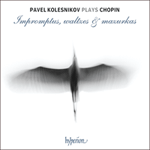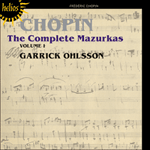The Mazurka in E major, Op 6 No 3, composed around the same time as the early version of Op 7 No 2, begins to hint at the complexity and ambiguity that Chopin embraced in the genre. The opening evokes a drone, but Chopin immediately adds destabilizing accents, making the metre sound duple rather than triple. The lively first tune behaves oddly: rather than end conclusively, it trails off on the dominant chord, with a recollection of the syncopated drone and low bass line of the opening. This tune recurs basically unchanged until the very last phrase of the piece, when Chopin finally allows it to resolve quietly, almost pensively. These and other gestures in the mazurka leave the realm of ethnographic reportage far behind.
from notes by Jeffrey Kallberg © 2019
La Mazurka en mi majeur, op.6 n° 3, composée à peu près à la même époque que la première version de l’op.7 n° 2, commence à faire comprendre la complexité et l’ambiguïté que Chopin adopta dans ce genre. Le début évoque un bourdon, mais Chopin ajoute d’emblée des accents déstabilisants, en faisant paraître une métrique binaire plutôt que ternaire. Le premier air animé se comporte bizarrement: au lieu de se terminer de façon concluante, il s’estompe sur l’accord de dominante avec une réminiscence du bourdon syncopé et de la ligne de basse du début. Cet air revient presque inchangé jusqu’à la toute dernière phrase du morceau, où Chopin la laisse finalement se résoudre calmement, presque pensivement. Ces gestes comme d’autres dans la mazurka vont bien au-delà de l’univers du reportage ethnographique.
extrait des notes rédigées par Jeffrey Kallberg © 2019
Français: Marie-Stella Pâris
Die Mazurka E-Dur, op. 6 Nr. 3, wurde etwa zur selben Zeit wie die Frühfassung von op. 7 Nr. 2 komponiert und weist bereits auf die Komplexität und Mehrdeutigkeit hin, die Chopin sich in dem Genre zu eigen machte. Zu Beginn kommt ein Bordunklang, doch fügt Chopin sofort destabilisierende Akzente hinzu, so dass das Metrum eher gerade als ungerade klingt. Die lebhafte erste Melodie verhält sich seltsam: sie schließt nicht eindeutig, sondern verstummt allmählich auf dem Dominantakkord mit einer Erinnerung an den synkopierten Bordunklang und die tiefe Basslinie des Anfangs. Diese Melodie wird praktisch unverändert wiederholt, bis Chopin sie ganz am Ende des Stücks sich ruhig, fast nachdenklich auflösen lässt. Diese und andere Gesten in der Mazurka lassen die Sphäre der ethnographischen Reportage weit hinter sich.
aus dem Begleittext von Jeffrey Kallberg © 2019
Deutsch: Viola Scheffel


 Chopin: Impromptus, waltzes & mazurkas
Chopin: Impromptus, waltzes & mazurkas Chopin: The Complete Mazurkas, Vol. 1
Chopin: The Complete Mazurkas, Vol. 1
